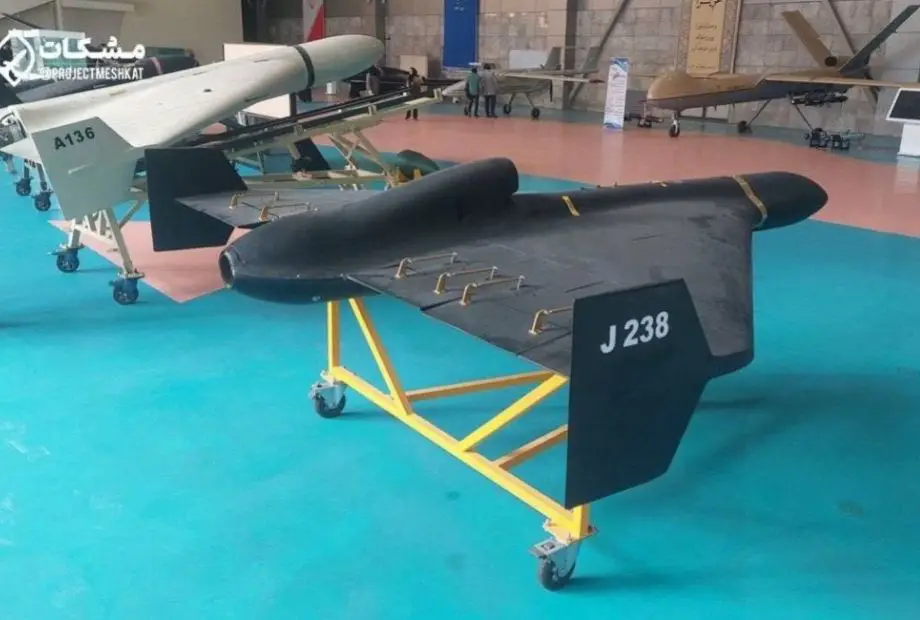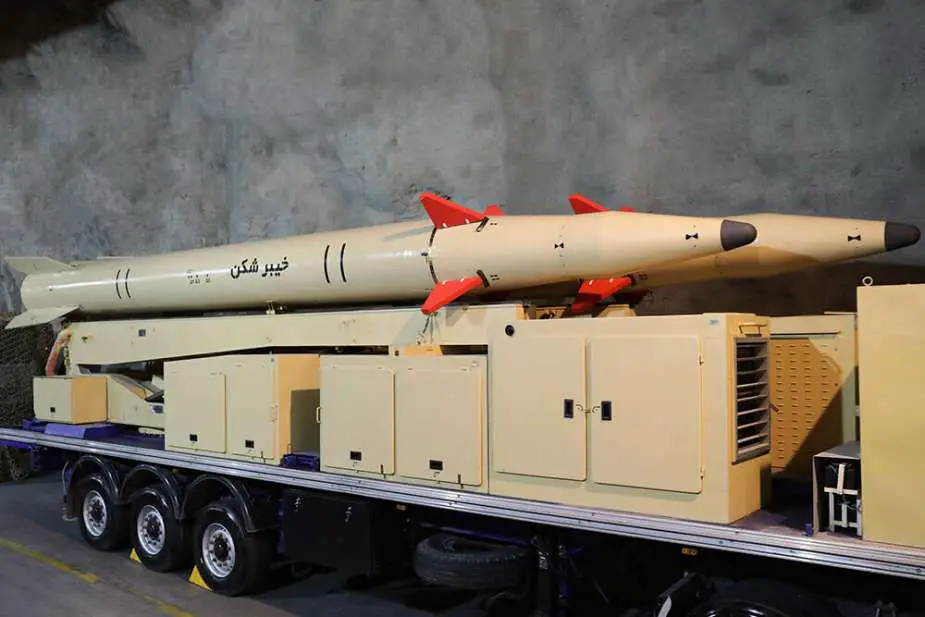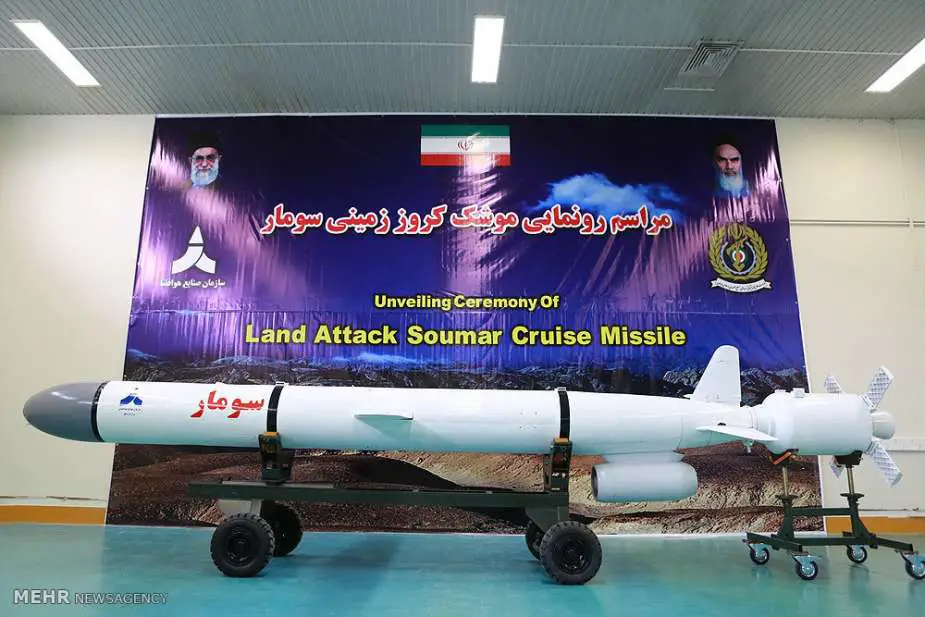According to the spokesperson of the Israel Defense Forces (IDF), Iran fired 170 drones, 110 ballistic missiles, and 30 cruise missiles at Israel on April 13, 2024. Iran launched a significant attack on Israel in retaliation for the bombing of a consulate in Syria by the Jewish state. An IDF spokesperson stated that the barrage of strikes had virtually no effect, as "99% of the drones and missiles" launched by Tehran were intercepted by the Israeli defense system and its American, British, French, and Jordanian allies. In this article, we detail all missiles and drones used by Iran to strike Israeli territory.
Follow Army Recognition on Google News at this link

Shahed 238 ( black Livery) Shahed 136 loitering munition also called kamikaze drone( white Livery ) (Picture source IRGC)
As a result, very little damage was caused. No drone entered Israel, and only a few missiles managed to hit their target, the Netivim military base in the south of Israel. The Islamic Republic described the operation as "limited and minimal" but showcased the diversity of its arsenal by using multiple attack vectors. In total, 170 killer drones, 110 ballistic missiles, and 30 cruise missiles were fired.
Shahed drones
The Shahed-136 drones appear to have been launched from Iran towards Israel last night. The Shahed-136 is an Iranian-made loitering munition, commonly referred to as a "kamikaze drone designed to deliberately crash into a target, detonating its onboard explosives upon impact.. They are also heavily used by Russia in its war against Ukraine. Their effectiveness is limited: guided by GPS, they can be jammed or destroyed by anti-air defenses. They can only target fixed locations, which limits their tactical value. With each Russian attack, the Ukrainian army boasts of intercepting many of them.
But the Shahed drones have two advantages: their range, several hundred kilometers, and their modest cost, which allows the attacker to save precision missiles and saturate air defenses. This tactic has only partially worked, as only a few rare ballistic missiles managed to breach the Israeli defenses.
During the attack by Iran, videos identified the use of the Shahed 238 drone, an evolution of the Shahed 136, with major improvements in propulsion; the Shahed 238 is equipped with a turbojet engine increasing its speed to over 500 kilometers per hour, compared to 180 for the Shahed 136.

The Kheibar is an Iranian-made medium-range ballistic missile. (Picture source Wikimedia)
Kheibar, Ghadr and Sejjil ballistic missiles
Among the 110 ballistic missiles fired at Israel, Iran seems to have used the medium-range ballistic missiles Kheibar Shekan, and Sejjil according to several observers. The Kheibar, also referred to as Khorramshahr-4, is a medium-range ballistic missile developed by Iran. It belongs to the fourth generation of the Khorramshahr missile family and is produced by the Ministry of Defense of the Islamic Republic of Iran. The missile was officially revealed on June 4, 2023, with Mohammad Reza Ashtiani, the Iranian Defense Minister, in attendance. Capable of reaching distances up to 2,000 km, the Khorramshahr ballistic missile can be equipped with a warhead weighing up to 1,500 kg.
The Ghadr-110, a medium-range ballistic missile, might also have been spotted in the Israeli skies. With a range of 2000 km and a payload of 650 to 1000 kg, it is an improvement of the Shahab 3 derived from the North Korean Nodong-1 missile. Iran also has other similar ballistic missiles, which might have been used in Israel: the Sejil, the Imad (still in development), and the Haj Qasem, named in honor of General Qasem Soleimani, killed in a US drone attack in January 2020.
The Sejjil missile is a domestically produced Iranian medium-range ballistic missile that utilizes a two-stage, solid-propellant design. Its development likely commenced in the late 1990s, building upon the technologies and designs of earlier Iranian missiles, notably the Zelzal short-range ballistic missile. The Sejjil's initial test flight took place in 2008, achieving a distance of 800 km. A subsequent test in May 2009 focused on enhancing its guidance and navigation systems. Since then, four additional tests have been conducted, with the most recent reaching roughly 1,900 km into the Indian Ocean.
The missile measures 18 meters in length and 1.25 meters in diameter, with a launch weight of 23,600 kg. It is capable of carrying a 700 kg payload over a distance of up to 2,000 km. Currently, it is equipped with high-explosive warheads, with the potential for nuclear capabilities in the future. The estimates of its range and payload capacity are based on the missile's construction from aeronautical-grade steel.
A ballistic missile is a rocket-propelled weapon designed to deliver explosives over a long distance with high precision. Upon launch, it follows a ballistic trajectory, involving an initial powered phase where the rocket engines propel the missile into an upward trajectory, followed by an unpowered phase that occurs as gravity pulls it back towards the Earth. This trajectory can carry the missile through the upper atmosphere or even into space before re-entering the atmosphere and descending toward its target. Ballistic missiles vary greatly in range and size, from short-range missiles that travel a few hundred kilometers to intercontinental ballistic missiles (ICBMs) capable of traveling over 10,000 km.

The Soumar is a long-range cruise missile fully designed and developed in Iran. (Picture source Wikimedia)
Cruise missiles
Iran also fired several cruise missiles on April 13, 2024, for the aerial attacks against Israel. None have been formally identified. Iran has been actively developing its cruise missile capabilities as part of its broader military strategy. The development of Iranian cruise missiles is an integral aspect of the country's defense posture, designed to enhance its long-range strike capabilities and provide a strategic deterrent.
The origins of Iran’s cruise missile program date back to the acquisition of Soviet Kh-55 cruise missiles in the early 2000s. Since then, Iran has embarked on an ambitious plan to reverse-engineer and enhance these designs to suit its specific strategic needs. Iranian engineers have focused on increasing the range, accuracy, and payload capacity of their cruise missiles.
Significant advancements were showcased with the unveiling of various models over the years, including the Soumar and the Hoveyzeh cruise missiles. These missiles are reported to have ranges of approximately 700 km and 1,350 km respectively, illustrating significant strides in propulsion and guidance technology
A cruise missile is a type of guided missile equipped with a jet engine, allowing it to fly at a consistently low altitude, closely following the earth's terrain, making it difficult to detect and intercept. It is designed to deliver a large warhead with high precision over long distances. Cruise missiles can be launched from various platforms including ships, submarines, aircraft, and ground facilities. They typically have a maximum range that can vary widely, but some advanced models can travel up to 2,500 kilometers or more, depending on their design specifics such as fuel capacity and engine efficiency.
Defense News April 2024
















